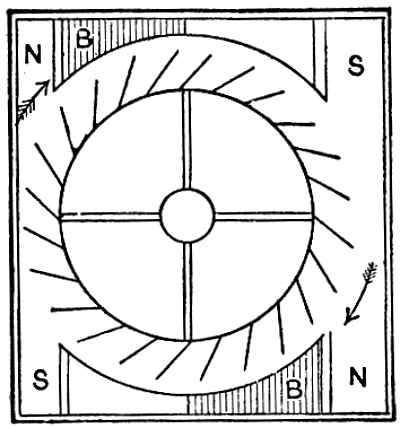23. Perpetual Motion
Magnetic
wheel
A light wheel
on friction rollers, set with slips of iron at an angle around its
periphery. N, N are two magnets, which, attracting the rim of the
wheel, will render one side lighter and the other heavier, causing it
to revolve ad infinitum: or, to render it more powerful, let the steel
rims be magnetized, and fixed on the wheel with their north poles
toward its center.

Let two more
magnets be added, as shown by the unshaded lines; let
these two, S, S, be placed with their south poles nearest the rim of
the wheel, and the other two, N, N, with their north poles in that
position. Now, as similar poles repel and opposite poles attract, the
wheel will be driven round by attraction and repulsion acting
conjointly on four points of its circumference. B, B are blocks of wood
to keep off the attraction of the magnets from that part of the wheel
which has passed them. No substance yet found that interrupts the
magnetic field.
From: Gardner D. Hiscox, M.E., Mechanical Appliances and Novelties of Construction (1927), Norman W. Henley Publ. Co.


Nature bears long with those who wrong her. She is patient under abuse. But when abuse has gone too far, when the time of reckoning finally comes, she is equally slow to be appeased and to turn away her wrath. (1882) --
Nathaniel Egleston, who was writing then about deforestation, but speaks equally well about the danger of climate change today.
 Carl Sagan
Carl Sagan: In science it often happens that scientists say, 'You know that's a really good argument; my position is mistaken,' and then they would actually change their minds and you never hear that old view from them again. They really do it. It doesn't happen as often as it should, because scientists are human and change is sometimes painful. But it happens every day. I cannot recall the last time something like that happened in politics or religion. (1987) ...
(more by Sagan) Albert Einstein: I used to wonder how it comes about that the electron is negative. Negative-positive—these are perfectly symmetric in physics. There is no reason whatever to prefer one to the other. Then why is the electron negative? I thought about this for a long time and at last all I could think was “It won the fight!” ...
(more by Einstein) Richard Feynman: It is the facts that matter, not the proofs. Physics can progress without the proofs, but we can't go on without the facts ... if the facts are right, then the proofs are a matter of playing around with the algebra correctly. ...
(more by Feynman)







